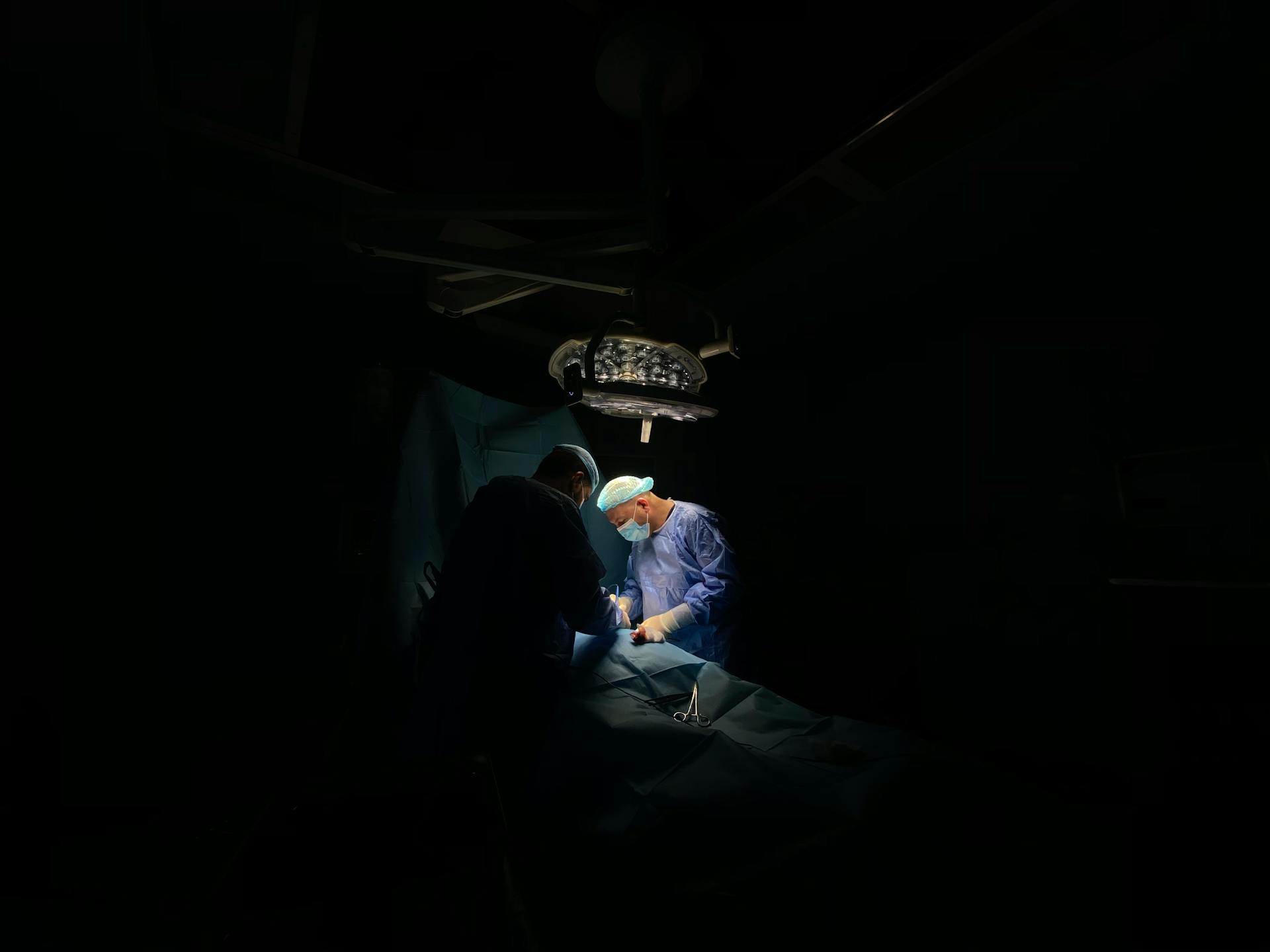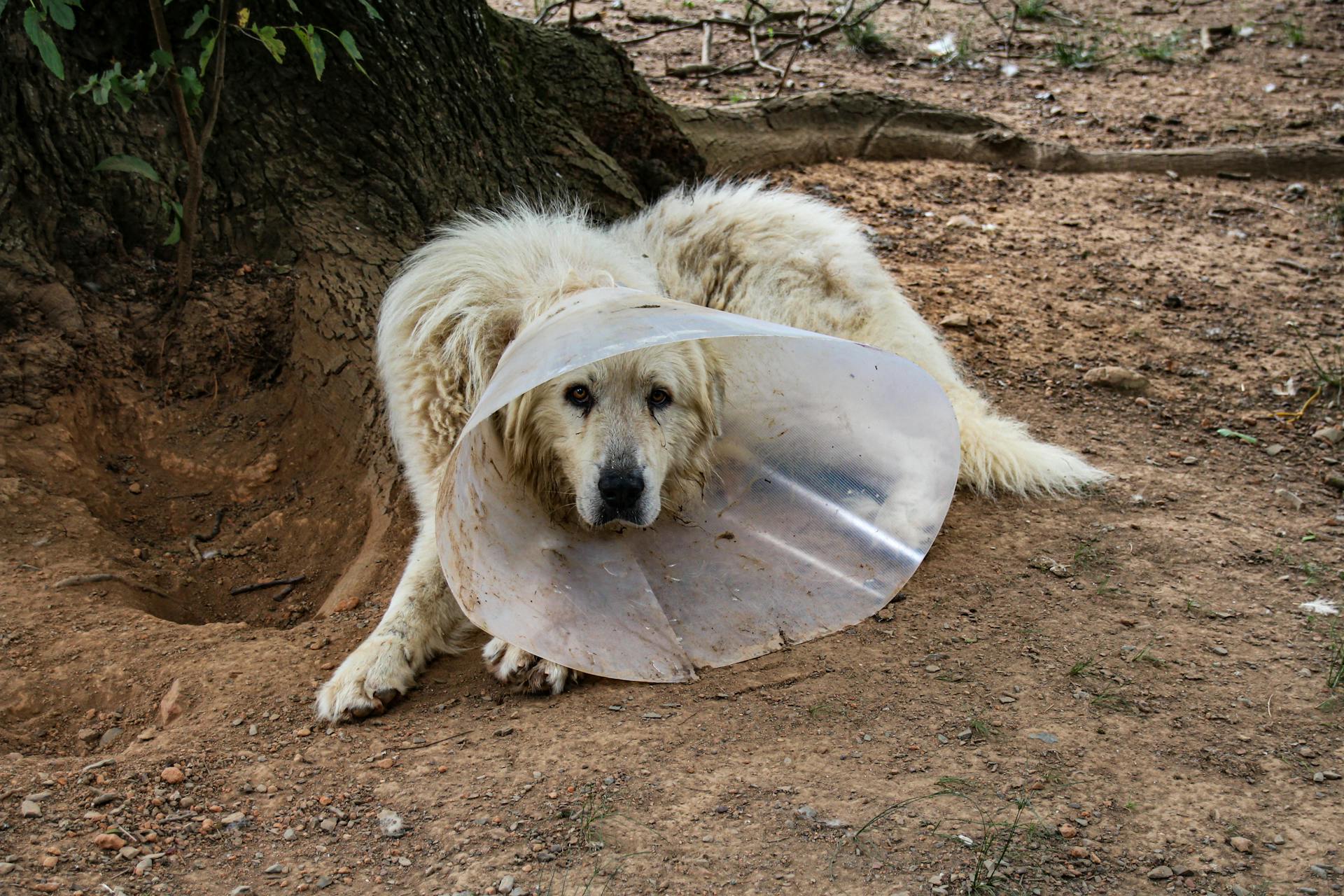
Perianal gland tumors in dogs are a type of cancer that affects the glands located near the anus.
These tumors can be benign or malignant, and they often grow slowly over time. They can also cause discomfort and pain for the dog.
Perianal gland tumors are most commonly found in middle-aged to older dogs, typically between the ages of 5 and 10.
Intriguing read: Perianal Fistula in German Shepherds
Causes and Risk Factors
Perianal gland tumors are more common in certain breeds, including Cocker Spaniels, Fox Terriers, and Siberian Huskies.
Testosterone plays a significant role in the development of perianal adenomas, which is why intact male dogs are at the highest risk.
Hormonal imbalances, specifically the presence of testosterone, stimulate the growth of perianal gland cells, leading to the formation of benign tumors.
Neutering can reduce the risk of developing perianal adenomas, but it's not a guarantee of complete prevention.
Female dogs that have not been spayed produce estrogen, which is thought to inhibit the growth of these tumors.
Diagnosis
Differential diagnosis of perianal gland tumors can be tricky, but it's essential to rule out other possible causes of your pet's symptoms. Anal sac impaction and rupture, blood parasite infection, and various types of neoplasia, such as anal sac neoplasia, perianal gland neoplasia, mast cell tumour, or melanoma, are all potential differential diagnoses.
A thorough examination, including a digital rectal exam, can help identify the type of tumor. In Tob's case, a cytology result and post-operative biopsy confirmed the presence of a perianal gland adenoma. This highlights the importance of diagnostic tests in determining the correct diagnosis.
A list of potential differential diagnoses includes:
- Anal sac impaction and rupture
- Neoplasia; anal sac neoplasia, perianal gland neoplasia, mast cell tumour, or melanoma.
- Blood parasite infection (comorbidity)
Diagnostics
Diagnostics play a crucial role in determining the correct treatment for a dog's condition.
Fine needle aspiration (FNA) was used to collect a sample from the mass under sedation. The first FNA result came back as highly likely to be a benign perianal gland adenoma, with surgical excision recommended.
The clinical signs exhibited by Tob were very typical of a perianal gland adenoma, which was confirmed by the first cytology result and the post-operative biopsy.
A digital rectal exam was not performed when Tob was first presented to the WVS Rescue and Rehabilitation Centre, but it's an important diagnostic tool that can help identify potential carcinomas.
Tob had two perianal adenomas, one at the periphery of the right anal sac and another at the base of his tail. The veterinary surgeon decided to remove the mass at the anal sac area but left the mass at the tail base to be monitored for future resection.
The surgical technique used in this case was suitable for a perianal gland adenoma, but a carcinoma would have required wide surgical margins, removal of local lymph nodes, and possibly radiation and/or chemotherapy.
A blood test was not performed to determine Tob's serum calcium level to detect hypercalcemia and rule-in/out an anal sac gland tumour.
You might enjoy: Turkey Tail Mushroom for Dogs Hemangiosarcoma
Physical Examination
A physical examination is a crucial step in diagnosing perianal tumours in dogs.
Careful rectal examination should be performed in all dogs with perianal tumours to estimate the tumour perimeters and possible complications associated with a surgical excision.
During a rectal examination, it may also be possible to palpate enlarged local lymph nodes in the pelvis, which can be difficult to see via ultrasound due to their deep location.
A rectal examination allows the veterinarian to assess the likelihood of the tumour being excised and plan the best course of treatment.
If this caught your attention, see: Multilobular Tumour of Bone
Treatment and Management
For small, non-ulcerated perianal adenomas, castration or surgical removal of the male dog's testicles is recommended to prevent progression.
Removing the tumor(s) is the primary treatment for perianal adenoma in dogs, typically performed under general anesthesia to preserve normal anal tissue.
In some cases, more aggressive surgical approaches or additional therapies like radiation may be necessary for extensive or malignant tumors.
Neutering, especially in intact male dogs, reduces testosterone levels and helps prevent the recurrence of perianal adenomas.
After surgery, your dog will need to wear a recovery collar or suit while their stitches heal, and antiseptic wipes may be recommended to aid in the healing process.
Treatment

Treatment for perianal adenoma in dogs typically involves surgically removing the tumor(s) under general anesthesia.
The goal of surgery is to remove the masses while preserving the normal anal tissue. In cases where the tumors are extensive or have become malignant, a more aggressive surgical approach or additional therapies may be necessary.
Neutering, especially in intact male dogs, is also recommended as it reduces testosterone levels and helps prevent the recurrence of perianal adenomas.
Regular monitoring and follow-up visits with your veterinarian are essential to detect any recurrence or signs of malignancy.
After surgery, your dog may need antibiotics and pain medication to ensure uncomplicated healing, especially if the surgical wound is close to the anus.
A simple continuous suture pattern in the subcutaneous layer and an intradermal suture pattern in the intradermal layer are commonly used to close the incision.
The surgical wound should be assessed frequently to ensure it heals properly.
Dog Recovery and Management
After treatment, your dog will need some time to recover. They'll likely need to wear a recovery collar or recovery suit while their stitches heal.
During this period, antiseptic wipes may be recommended to help keep the area clean and promote healing. This will help prevent infection and support your dog's overall recovery.
Male dogs who aren't castrated may be more prone to developing new perianal adenomas. So, if your dog isn't neutered, it's essential to consider this risk and discuss it with your veterinarian.
Readers also liked: Do Goldendoodles Need Their Glands Expressed
Secondary Treatment Plan
After the initial treatment, Tob's blood results returned to normal and the infection was resolved, making him ready for surgery.
The veterinary surgeon decided to focus on removing the larger mass in the perineal area, which was causing Tob discomfort.
Tob had been exhibiting signs of discomfort, frequently barking and looking at his rear throughout the day.
The surgeon chose not to remove the smaller mass at the tail base, as it wasn't causing Tob any detectable irritation.
This decision was made to avoid an extended anesthesia time and potential complications.
The plan was to monitor the smaller mass for one month after castration to see if it would resolve on its own.
Types and Forms
Perianal gland tumors can be classified into two main forms: benign and malignant. The benign form is generally more treatable than the malignant form.
The malignant form, also known as perianal adenocarcinomas, is a serious condition that doesn't respond well to neutering. In fact, surgical removal of the tumor with sufficient margins is usually the best course of action.
In some cases, up to half of the anal sphincter can be removed without causing fecal incontinence.
Benign Form
Perianal adenomas are a type of benign tumor that can affect dogs. They are typically pink, hairless, and slow-growing, and are usually less than one inch in diameter.
These tumors can become ulcerated or infected, but are not cancerous. They are often found around the anus, prepuce, or under the tail.
Perianal adenomas are sensitive to hormones, particularly male hormones, which can stimulate their growth. This is why castration, or neutering, is often recommended for male dogs to prevent the progression of this tumor.
The growth of perianal adenomas is linked to sex hormones, and their development and growth are stimulated by male hormones and suppressed by female hormones. This is why they are more common in uncastrated male dogs.
Castration can be an effective way to treat perianal adenomas, with up to 90% of male dogs being cured via neutering and removal of the tissue mass.
Malignant Form
The malignant form of perianal tumors is a serious condition that requires immediate attention. Unfortunately, it doesn't respond to neutering, so surgical removal is the best course of action.
To remove the tissue mass, the surgeon must take sufficient margins to ensure that all affected tissue is removed. Luckily, up to half of the anal sphincter can be removed without causing fecal incontinence.
Insufficient margins obtained during the first operation are the main cause of reoccurrence, which can lead to multiple palliative removals over the years. This can be a challenging and stressful process for both the dog and its owner.
Radiotherapy after surgery can help subdue local reoccurrence and improve the chances of a successful outcome.
Frequently Asked Questions
What is the life expectancy of a dog with a perianal tumor?
Life expectancy for a dog with a perianal tumor varies from 18 months to 2 years, depending on treatment options. Treatment discussions and options can significantly impact a dog's quality of life and life expectancy.
How fast do perianal tumors grow?
Perianal tumors can grow slowly over months or years, often without causing immediate discomfort to your dog. However, their gradual growth can eventually lead to rupture and bleeding, requiring prompt veterinary attention.
What is a perianal mass in a female dog?
A perianal mass in a female dog is a slow-growing, non-painful lump that typically appears in the hairless area around the anus. It's usually a benign growth, but it's essential to have it checked by a veterinarian to rule out any underlying health issues.
How much does it cost to treat perianal adenoma in female dog?
Treatment costs for perianal adenoma in female dogs range from $500 to $1500, depending on the tumor's location and size, as well as the level of care chosen. Consult a veterinarian for a more accurate estimate and to discuss treatment options.
Are perianal tumors in dogs cancerous?
Perianal tumors in dogs can be either benign or malignant, with adenocarcinomas being a type of cancerous tumor that occurs in this area. It's essential to consult a veterinarian for a proper diagnosis and treatment plan.
Sources
- https://www.petmd.com/dog/conditions/skin/perianal-adenoma-dogs
- https://wvs.academy/case-reports/tob-perianal-gland-adenoma/
- https://oncowaf.be/en/Cancer/tumorInfo/perianalGlandTumor
- https://wvs.academy/case-reports/ocean-perianal-gland-tumour/
- https://collegehillsvet.com/perianal-adenoma-in-dogs-causes-symptoms-and-treatment/
Featured Images: pexels.com


